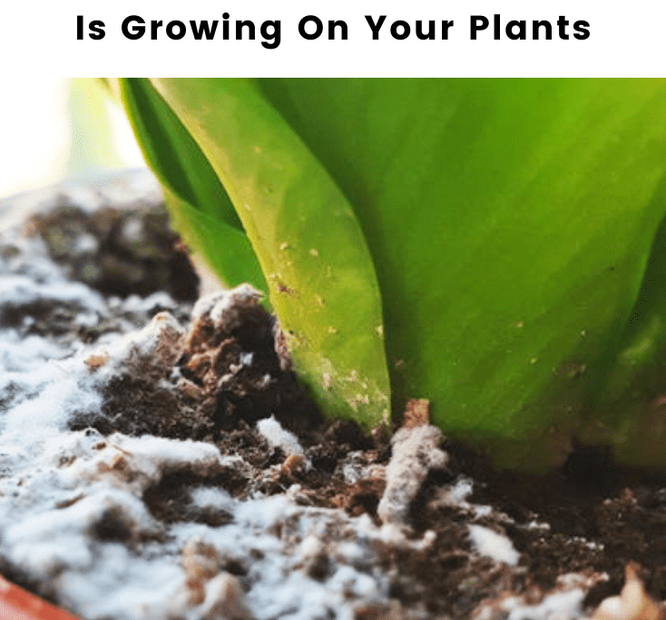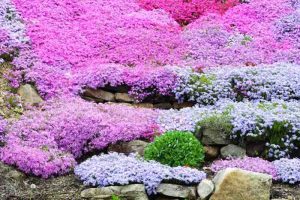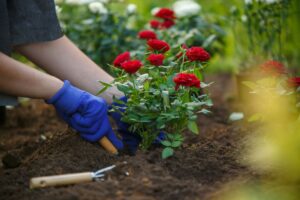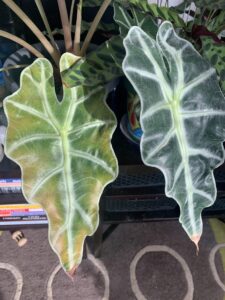Mold on Your Houseplant Soil? Here Are 4 Ways to Fix It
Your houseplants are a beautiful addition to your home, but they can also be a source of mold.
If you see mold on your houseplant soil, don’t panic. There are a few simple steps you can take to get rid of it and keep your plants healthy.Mold is a type of fungus that can grow on wet surfaces, and it can be harmful to both your plants and your health..
In this article, we’ll discuss what mold is, why it’s a problem, and how to get rid of it. We’ll also provide tips for preventing mold from growing in the future.

So if you’re dealing with mold on your houseplant soil, read on for all the information you need to know.
Mold on Your Houseplant Soil? Here Are 4 Ways to Fix It
Mold is a common problem for houseplants, but it can be easily fixed. Here are four ways to get rid of mold on your houseplant soil:
- Remove the moldy soil. The first step is to remove all of the moldy soil from the pot. You can do this by carefully scooping it out with a spoon or trowel. Be sure to get all of the moldy soil, as any remaining mold can quickly spread to the rest of the plant.
- Wash the pot. Once you have removed the moldy soil, it is important to wash the pot thoroughly. This will help to remove any remaining mold spores and prevent them from spreading to other plants. You can wash the pot with a mild soap and water, or you can use a commercial cleaner that is specifically designed for cleaning pots.
- Dry the pot thoroughly. After you have washed the pot, it is important to dry it thoroughly. This will help to prevent mold from growing back. You can dry the pot by setting it in the sun, or you can use a hair dryer on the low setting.
- Repot the plant in fresh soil. Once the pot is clean and dry, you can repot the plant in fresh soil. Be sure to use a well-draining potting mix that will help to keep the soil from becoming too wet.
By following these four steps, you can easily get rid of mold on your houseplant soil and prevent it from coming back.
Additional tips:
- If you have a lot of houseplants, it is a good idea to rotate them out of their pots every few months. This will help to prevent mold from growing in the soil.
- You can also help to prevent mold by watering your plants from the bottom. This will help to keep the leaves dry, which will discourage mold growth.
- If you notice that your plants are starting to develop mold, you can try spraying them with a fungicide. This will help to kill the mold and prevent it from spreading.
What is Mold?
What is Mold?
Mold is a type of fungus that can grow on a variety of surfaces, including soil, plants, and food. It is typically found in moist, warm environments and can cause a variety of health problems, including respiratory infections, skin irritation, and allergic reactions.
There are a number of different types of mold, each with its own unique appearance and characteristics. Some of the most common types of mold found on houseplants include:
- White mold: This type of mold is typically found on the surface of soil and is characterized by its white, fluffy appearance. It is not typically harmful to plants, but it can be unsightly.
- Black mold: This type of mold is typically found on the leaves of plants and is characterized by its dark, blackish-green appearance. It can be harmful to plants and can cause a variety of health problems in humans.
- Green mold: This type of mold is typically found on the leaves of plants and is characterized by its green, fuzzy appearance. It can be harmful to plants and can cause a variety of health problems in humans.
If you suspect that your houseplants have mold, it is important to take steps to remove it as soon as possible. You can do this by:
- Removing the affected plants from the area.
- Cleaning the affected area with a mixture of water and bleach.
- Allowing the area to dry completely before replacing the plants.
If you are concerned about the health of your plants or your own health, it is important to consult with a qualified professional.
Why Is Mold Bad for Houseplants?
Why Is Mold Bad for Houseplants?
Mold is a type of fungus that can grow on a variety of surfaces, including houseplants. While mold is not typically harmful to humans, it can be harmful to houseplants. Mold can cause a number of problems for houseplants, including:
- Root rot: Mold can cause the roots of houseplants to rot, which can eventually kill the plant.
- Leaf spot: Mold can also cause leaf spots, which can lead to the leaves falling off the plant.
- Disease: Mold can also spread diseases to other plants.
If you see mold on your houseplants, it is important to take steps to remove it as soon as possible. Here are a few tips for removing mold from houseplants:
- Remove the affected leaves: If the mold is only on a few leaves, you can simply remove the affected leaves. Be sure to wear gloves when handling the moldy leaves, as you do not want to spread the mold to other plants.
- Spray the plant with a fungicide: If the mold is more widespread, you can spray the plant with a fungicide. Be sure to follow the directions on the fungicide label carefully.
- Repot the plant: If the mold has reached the roots of the plant, you will need to repot the plant in fresh soil. Be sure to clean the pot thoroughly before repotting the plant.
By following these tips, you can help to keep your houseplants healthy and free of mold.
Table of Contents
- Why Is Mold Bad for Houseplants?
- How to Remove Mold from Houseplants
- Preventing Mold on Houseplants
How to Tell If Your Houseplant Soil Has Mold
How to Tell If Your Houseplant Soil Has Mold
Mold is a common problem for houseplants, especially if they’re kept in humid conditions. Mold can cause a number of problems for your plants, including stunted growth, wilting leaves, and root rot.
There are a few ways to tell if your houseplant soil has mold.
- Look for white, fuzzy growth on the soil surface. This is the most common sign of mold.
- Check for a musty smell. Moldy soil will often have a strong, unpleasant odor.
- Feel the soil. If the soil feels damp and slimy, it’s likely to be moldy.
If you suspect that your houseplant soil has mold, it’s important to take action to remove it. Mold can quickly spread to other plants and cause serious damage.
How to Remove Mold from Houseplant Soil
To remove mold from houseplant soil, you can follow these steps:
- Remove the plant from the pot.
- Rinse the roots of the plant under running water.
- Discard the old soil.
- Wash the pot with a solution of 1 part bleach to 9 parts water.
- Rinse the pot thoroughly.
- Replant the plant in fresh soil.
Once you’ve removed the mold from the soil, it’s important to take steps to prevent it from coming back.
- Keep the soil moist, but not soggy. Mold thrives in moist conditions, so it’s important to make sure that the soil is not too wet.
- Aerate the soil regularly. Aerating the soil helps to improve drainage and prevents the soil from becoming too compacted.
- Rotate the plant regularly. Rotating the plant will help to expose all sides of the plant to sunlight and air, which will help to prevent mold growth.
- Fertilize the plant regularly. Fertilizing the plant will help to promote healthy growth and make the plant more resistant to mold.
By following these tips, you can help to keep your houseplants healthy and free of mold.
4 Ways to Get Rid of Mold on Houseplant Soil
4 Ways to Get Rid of Mold on Houseplant Soil
Mold is a common problem for houseplants, especially if they are kept in humid conditions. Mold can cause a variety of problems for your plants, including stunted growth, yellowing leaves, and root rot. If you suspect that your houseplants have mold, it is important to take action to remove it as soon as possible.
Here are 4 ways to get rid of mold on houseplant soil:
- Remove the moldy soil. The first step is to remove the moldy soil from the pot. You can do this by carefully scooping out the soil with a spoon or trowel. Be sure to remove all of the moldy soil, as even a small amount can cause the mold to come back.
- Wash the pot. Once you have removed the moldy soil, it is important to wash the pot thoroughly. You can do this by filling the pot with a mixture of water and bleach (1 part bleach to 9 parts water). Let the pot soak for several minutes, then rinse it thoroughly with water.
- Dry the pot and plant. After you have washed the pot and plant, it is important to dry them thoroughly. You can do this by placing them in a sunny spot for several hours.
- Treat the plant with a fungicide. To prevent the mold from coming back, you can treat the plant with a fungicide. You can find fungicides at most garden centers. Be sure to follow the directions on the label carefully.
By following these steps, you can easily get rid of mold on houseplant soil and prevent it from coming back.
Table of Contents
- How to Get Rid of Mold on Houseplant Soil
- Step 1: Remove the Moldy Soil
- Step 2: Wash the Pot
- Step 3: Dry the Pot and Plant
- Step 4: Treat the Plant with a Fungicide
- Preventing Mold on Houseplant Soil
- Conclusion
Preventing Mold in Houseplant Soil
Preventing Mold in Houseplant Soil
Mold is a common problem for houseplant owners, but it can be easily prevented by following a few simple tips.
- 1. Use a well-draining potting mix. Mold thrives in moist soil, so it’s important to use a potting mix that drains well and allows excess water to evaporate. You can also add perlite or pumice to your potting mix to help improve drainage.
- 2. Water your plants properly. Overwatering is one of the most common causes of mold in houseplants. Make sure to water your plants only when the soil is dry to the touch. You can also help prevent mold by bottom-watering your plants, which means pouring water into the pot until the water comes out of the drainage holes.
- 3. Repot your plants as needed. If your plants are starting to outgrow their pots, it’s time to repot them. This will give the roots more space to grow and will help prevent the soil from becoming too compacted.
- 4. Keep your plants away from drafts. Drafts can dry out the soil and make it more susceptible to mold. If you live in a drafty area, try to keep your plants in a sheltered spot.
By following these tips, you can help prevent mold from growing in your houseplants.
Table of Contents
- What is Mold?
- How Does Mold Grow?
- How to Prevent Mold in Houseplant Soil
- How to Get Rid of Mold in Houseplant Soil
What is Mold?
Mold is a type of fungus that grows in moist, warm environments. It can be found on a variety of surfaces, including soil, plants, and food. Mold can cause a variety of health problems, including allergic reactions, respiratory problems, and skin irritation.
How Does Mold Grow?
Mold spores are present in the air all around us. They can be carried into your home on your clothes, shoes, or pets. Mold spores need moisture to grow, so they are more likely to grow in moist environments, such as houseplant soil.
How to Prevent Mold in Houseplant Soil
There are a few things you can do to prevent mold from growing in your houseplant soil.
- Use a well-draining potting mix. Mold thrives in moist soil, so it’s important to use a potting mix that drains well and allows excess water to evaporate. You can also add perlite or pumice to your potting mix to help improve drainage.
- Water your plants properly. Overwatering is one of the most common causes of mold in houseplants. Make sure to water your plants only when the soil is dry to the touch. You can also help prevent mold by bottom-watering your plants, which means pouring water into the pot until the water comes out of the drainage holes.
- Repot your plants as needed. If your plants are starting to outgrow their pots, it’s time to repot them. This will give the roots more space to grow and will help prevent the soil from becoming too compacted.
- Keep your plants away from drafts. Drafts can dry out the soil and make it more susceptible to mold. If you live in a drafty area, try to keep your plants in a sheltered spot.
How to Get Rid of Mold in Houseplant Soil
If you do find mold growing in your houseplant soil, there are a few things you can do to get rid of it.
- Remove the moldy soil. The best way to get rid of mold is to remove the moldy soil. You can do this by carefully removing the plant from the pot and shaking off the soil. Then, rinse the roots of the plant with water.
- Clean the pot. Once you have removed the moldy soil, you need to clean the pot. You can do this by washing it with a mixture of water and bleach.
- Replant the plant. Once the pot is clean, you can replant the plant in fresh soil. Make sure to water the plant well and keep it in a sheltered spot.
By following these tips, you can help prevent mold from growing in your houseplant soil and keep your plants healthy.
Resources
1. How to Get Rid of Mold on Houseplant Soil
This article from The Spruce provides detailed instructions on how to identify and remove mold from houseplant soil. It also includes tips on how to prevent mold from growing in the future.
2. How to Fix Moldy Houseplant Soil
This article from Gardening Know How provides similar information to the article from The Spruce, but it also includes some additional tips on how to improve the drainage of your houseplant soil to prevent mold from growing in the future.
Key Takeaways
Outro
Mold on your houseplant soil is a common problem, but it’s one that can be easily fixed. By following these four tips, you can get your plants back to their healthy, green selves in no time.
So next time you see mold on your houseplant soil, don’t despair. Just follow these tips and you’ll be on your way to a mold-free home in no time.
For more information on how to care for your houseplants, visit our blog or check out our book, “The Complete Guide to Houseplant Care.”
- Cat Palm vs Majesty Palm: Which Should You Choose? - June 30, 2024
- Flowers That Survive Winter: Discover the Exceptional No. 5 - June 30, 2024
- The Ultimate Guide to the Growth and Care of the Black Pagoda Lipstick Plant - June 29, 2024





